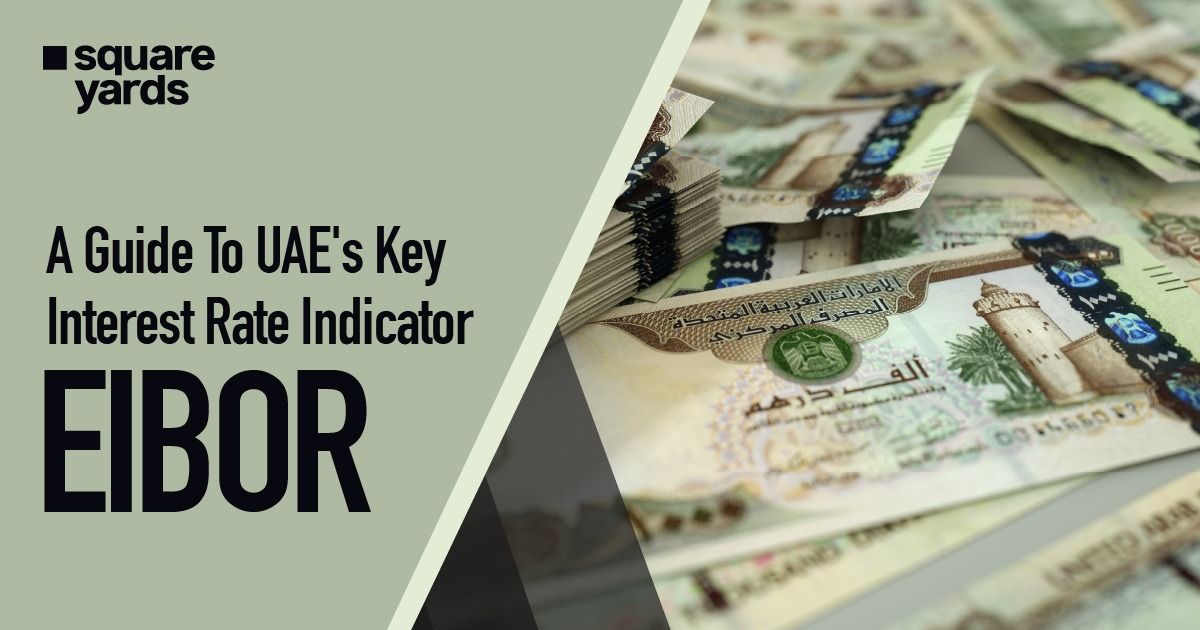The Emirates Interbank Offered Rate (EIBOR) is super important for interest rates on loans and savings in the UAE. It’s updated daily and shows how much it costs banks in the UAE to lend money to each other. Knowing the EIBOR rate today in UAE can help you make smart money decisions, whether you’re getting a mortgage, a personal loan, or business financing. This blog provides the latest updates on EIBOR, its impact on your finances, and helpful tips to better understand UAE financial landscape.
What Do You Mean by EIBOR?

The Emirates Interbank Offered Rate (EIBOR) is the benchmark interest rate used in the UAE for lending between banks and pricing various financial products, including mortgages, personal loans, and corporate financing. The Central Bank of the UAE calculates EIBOR daily, reflecting the average rates at which major UAE banks lend to each other. EIBOR rate today UAE is crucial in maintaining market stability and promoting healthy competition among lenders, contributing to overall economic confidence in the UAE financial market. Reforms in 2018 enhanced the transparency and accuracy of EIBOR calculations, ensuring greater accountability.
Let’s learn more about the Emirates InterBank Offered Rate and understand why it is crucial for the UAE.
How is the Rate of EIBOR Determined?
The EIBOR rate is determined by averaging the daily rates from a panel of nine UAE Dirhams (AED) banks. The highest and lowest two rates are excluded from calculating this rate, and the average of the remaining rates is taken. Initially calculated by the UAE Central Bank, the task was outsourced to Thomson Reuters Ltd. on April 15, 2018.
Don’t forget, you can access historical rates from October 2009 and daily updated rates on the Central Bank’s website. The EIBOR rate today UAE shows the interest rates that banks report for interbank loans. The rate is determined every business day at 11:00 am UAE time, except on Fridays and Saturdays.
Significance Of EIBOR
The key benchmark for financial operations in the United Arab Emirates is the Emirates Interbank Offered Rate, or EIBOR. It provides uniformity and openness in lending procedures, making it simple for borrowers to evaluate loan offers from various banks. This encourages competition among lenders, which benefits borrowers by resulting in better loan terms. The EIBOR rate today UAE is a reliable indicator of interest rates. It helps set prices for financial products like bonds and loans, which keeps the market stable. Investors benefit from this stability, which lowers uncertainty and upholds general economic trust in the UAE financial market.
EIBOR in Comparison to Competing Benchmarks
Despite being widely used in the UAE, it is essential to understand the key differences and similarities between EIBOR and other benchmark rates. The widely used London interbank offered rate, or LIBOR, is one example of such a benchmark. LIBOR is derived from estimates provided by a panel of banks, in contrast to the EIBOR rate forecast for 2024, which is determined using actual borrowing rates in the UAE interbank market. Likewise, when compared to EIBOR, LIBOR covers a wider range of tenors and currencies.
On comparing EIBOR to other benchmarks, we notice several important differences–
-
- EIBOR and the London Interbank Offered Rate—LIBOR differ primarily in their basis; EIBOR is based on UAE banks’ lending rates, while LIBOR is derived from international banks in London. EIBOR is often less volatile due to the stable UAE economic environment.
- The Secured Overnight Financing Rate, or SOFR, replaces LIBOR in many jurisdictions. Unlike the unsecured EIBOR, it offers more transparency and reduced manipulation risk due to its reliance on overnight repurchase agreements.
- The Euro Interbank Offered Rate, or EURIBOR, serves the Eurozone with European regulatory standards, making it distinct from the locally focused EIBOR, tailored to the UAE’s economic conditions.
- The Tokyo Interbank Offered Rate—TIBOR serves Japan. While EIBOR and TIBOR are based on regional interbank lending rates, their economic environments and market dynamics differ significantly.
- EIBOR’s local relevance and recent transparency reforms highlight its importance in the UAE financial market. These ensure it remains a stable and credible benchmark amidst ongoing global transitions in interbank offered rates.
Factors Influencing EIBOR Rate Today Dubai
-
- Market Supply and Demands: EIBOR rates rise with high demand for credit and fall with low borrowing.
- Monetary Guidelines: The UAE central bank’s policy changes can affect EIBOR rates.
- Market Conditions: Liquidity and credit risks in the interbank market impact EIBOR rates.
- International Interest Rates: Changes in global rates, especially the US dollar, influence EIBOR rates in the UAE.
The Significance of EIBOR in the UAE Financial Market

As a major benchmark for figuring out interest rates on various financial goods, such as loans and mortgages, the Emirates Interbank Offered Rate, or EIBOR, is very important in the UAE financial sector. EIBOR affects savings rates and borrowing prices throughout the economy by reflecting the cost at which banks lend to one another. Its swings reveal the state of the economy and liquidity, affecting consumers and companies. Its dependability and openness have been improved recently, guaranteeing that it will always be a reliable reference rate. The function of EIBOR is essential for upholding investor confidence and promoting effective financial activities in the United Arab Emirates.
1. Indicator of Market Conditions
EIBOR shows the current market conditions in the UAE. It indicates the supply and demand in interbank lending, giving a view of the banking sector’s health. Changes in EIBOR rates signal shifts in market mood, liquidity, and borrowing costs. Therefore, market participants watch EIBOR closely to understand the economy and make smart financial choices.
2. Pricing of Financial Products
The benchmark rate used to determine the cost of financial products is the EIBOR. Interest rates on loans, mortgages, and other credit services are determined by banks and other financial institutions using the EIBOR. Due to its impact on borrowing costs, borrowers must comprehend EIBOR. Loans are less expensive when EIBOR rates are low, and borrowing costs increase when EIBOR rates are high.
3. Risk Management
EIBOR is crucial for banks and financial institutions in managing risk. It provides a standard to help control interest rate risk. For example, banks can use EIBOR to make interest rate swap deals, protecting themselves from rate changes. Using EIBOR as a guide, financial institutions can match their interest rate risks with market trends, minimising possible losses.
4. Comparison with Other Benchmark Rates
It’s important to compare the UAE’s EIBOR benchmark rate with other rates like LIBOR and SAIBOR to understand how attractive and competitive the UAE market is to foreign investors. Comparing these rates can also help in evaluating the appeal of different regional markets.
5. Regulatory Considerations
EIBOR rate today in UAE is regulated by authorities such as the Central Bank to ensure clear, reliable rates that reflect current market conditions. Understanding EIBOR is essential for effective navigation of the financial landscape, as it impacts the pricing of financial products and assists with risk management.
Where Are The EIBOR Rates Available?
Some of the sources that can be a great help in finding out the EIBOR rate history chart and the EIBOR rate today in UAE are as follows—
-
- The most authoritative source for EIBOR rates is the UAE Central Bank. They publish the daily EIBOR rates on their official website, www.centralbank.ae.
- Other sources may include, Websites such as Reuters, Bloomberg, and other financial news platforms, which often report on EIBOR rates and provide updates on market trends.
- Platforms like CEIC Data and other economic data aggregators provide historical and current EIBOR rates.
- Many UAE banks, including Emirates NBD, First Abu Dhabi Bank, and others, publish current EIBOR rates on their websites as part of their financial product information.
Future of Interest Rate and EIBOR
Global financial markets have seen substantial modifications recently, including adjustments to benchmark rates like LIBOR. Similarly, the UAE is changing the UAE Dirham Interbank Offered Rate (UAE DIBOR) in place of the EIBOR. This shift aims to improve benchmark rates’ stability and dependability using global best practices.
Market participants must be informed about the changes during this transition and modify their financial strategy as necessary. Anyone in the UAE’s financial sector must know about the EIBOR rate forecast and its aftermath. Knowledge of EIBOR enables you to manage the constantly changing market dynamics and make wise financial decisions, whether you are a lender, investor, or borrower.
Similar Suggestions For You:
|
Mortgage In Dubai |
|
|
Opening a Bank Account in Dubai |
|
|
Topmost Mortgage Mistakes to Avoid |
|
|
Home Finance Option |
Frequently Asked Questions(FAQ’s):
When the EIBOR rate history chart shows an increase in the UAE financial market, it usually means that borrowing costs will be higher. This often indicates tighter liquidity constraints or that institutions are assessing higher risks. Higher EIBOR rates indicate cautious or unfavourable economic conditions, showing that banks are less willing to lend to each other without the expectation of larger profits.
Yes, you can get a loan with a lower interest rate by choosing a fixed-rate loan instead of a variable-rate loan tied to EIBOR or by taking advantage of special offers from banks.
No, EIBOR is not the same as the interest rates on your loan or savings account. Banks use the EIBOR rate today in UAE as a benchmark to set interest rates for their financial products. The interest rates on loans or savings accounts will include an extra amount set by the bank.
A rising EIBOR can benefit investors holding fixed-income securities or savings accounts with interest rates linked to EIBOR, leading to higher returns. However, it might also raise borrowing costs, negatively impacting investment returns if financing is needed.
Yes, a higher EIBOR will typically lead to higher interest payments on variable-rate mortgages linked to EIBOR.
The EIBOR rate fluctuates based on market conditions. As of June 2024, for example, the overnight EIBOR was reported at approximately 5.245% per year.
The 3-month EIBOR rate indicates the interest rate at which UAE banks are willing to lend to each other for a three-month period. It is a benchmark for setting rates on various financial products, including loans and mortgages.
The average interest rate in the UAE varies depending on the financial product. For instance, mortgage rates can range from 2.5% to 4.5%, while personal loan rates might be higher. EIBOR influences these rates but does not directly reflect the average consumer interest rate.
EIBOR is calculated using interest rates submitted by a panel of banks. The rates reflect the interest rates at which they are willing to lend unsecured funds to other banks. The highest and lowest rates submitted are not included. The remaining rates are averaged to determine the daily EIBOR. What does a rising EIBOR indicate?
Can I get a loan with a lower interest rate?
Is EIBOR the same as interest rates on my loan/savings account?
Can a rising EIBOR benefit me as an investor?
Will a higher EIBOR result in me paying more interest on my mortgage?
What is the EIBOR rate in the UAE?
What does the 3 months EIBOR rate today signify?
What is the average interest rate in the UAE?
How is EIBOR calculated?




